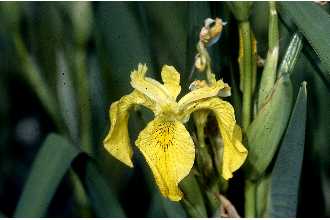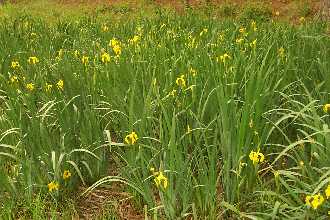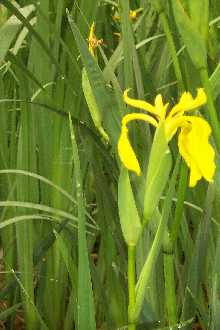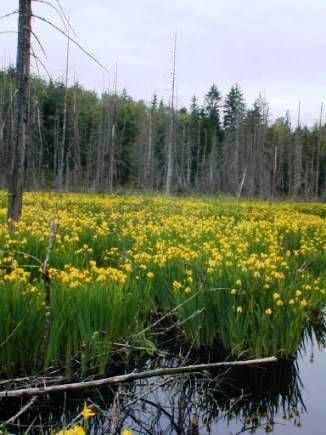Yellow flag iris identification and control
Iris pseudacorus

This Class C noxious weed is widespread throughout western Washington. Control is recommended but not required in King County. For more information on noxious weed regulations and definitions, see Noxious weed lists and laws.
Description
When flowering, yellow flag iris is unmistakable with its showy yellow flowers colorfully displayed along the edge of water and in wetlands. In Washington, the flowers occur in late spring or early summer.
Several flowers can occur on each stem, along with one or two leafy bracts. Each flower resembles a common garden iris. The leaves are mostly basal and are folded and clasp the stem at the base in a fan-like fashion. Yellow flag iris is perennial, and will remain green during winter where the weather is mild. It has stout rhizomes and long, spreading roots. Seeds form in large, glossy green, triangular capsules. The seeds are corky. The plants spread by rhizomes and grow tightly bunched together.

This is the only yellow iris found in Washington’s wet areas, but when not flowering it may be confused with cattail (Typha latifolia) or broad-fruited bur-reed (Sparganium eurycarpum). Look for the fruits in the summer, or the fan-shaped plant-base at other times of year.
Yellow flag iris will sicken livestock if ingested, and is generally avoided by herbivores (although muskrats will eat the rhizomes). Contact with the resins can cause skin irritation in humans.
Geographic distribution
Yellow flag is native to Europe, Great Britain, North Africa and the Mediterranean region. It has been introduced in temperate areas nearly world-wide and occurs throughout the United States.
Additional information on yellow flag iris
- King County Noxious Weed Alert for Yellow Flag Iris
- King County Best Management Practices for Yellow Flag Iris
- Washington State Noxious Weed Control Board (external link)
What to do if you find this plant in King County, Washington
Because yellow flag iris is so widespread, property owners in King County are not required to control it and we are not generally tracking infestations. We can provide advice on how to control yellow flag iris, but there is generally no legal requirement to do so.
Yellow flag iris photos


Related information
Related agencies
Program offices are located at 201 S. Jackson St., Suite 600, Seattle, WA 98104. To contact staff, see the Noxious Weed Control Program Directory, send an email, or call 206-477-WEED (206-477-9333).

 Translate
Translate